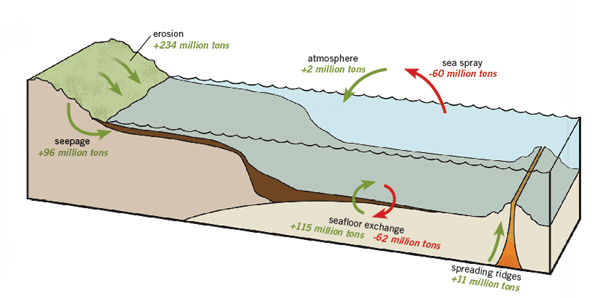
Very Little Salt in the Sea
Best Evidences From Science That Confirm a Young Earth
If the world’s oceans have been around for three billion years as evolutionists believe, they should be filled with vastly more salt than the oceans contain today.
Every year rivers, glaciers, underground seepage, and atmospheric and volcanic dust dump large amounts of salts into the oceans (Figure 1). Consider the influx of the predominant salt, sodium chloride (common table salt). Some 458 million tons of sodium mix in with ocean water each year,1 but only 122 million tons (27%) are removed by other natural processes2 (Figure 1).
After 3 billion years, we would expect to see 70x more salt in the ocean than we see today.
If seawater originally contained no sodium (salt) and the sodium accumulated at today’s rates, then today’s ocean saltiness would be reached in only 42 million years3—only about 1/70 the three billion years evolutionists propose. But those assumptions fail to take into account the likelihood that God created a saltwater ocean for all the sea creatures He made on Day Five. Also, the year-long global Flood cataclysm must have dumped an unprecedented amount of salt into the ocean through erosion, sedimentation, and volcanism. So today’s ocean saltiness makes much more sense within the biblical timescale of about six thousand years.4
Salt in the Sea
The Numbers Just Don’t Add Up

Figure 1: Every year, the continents, atmosphere, and seafloor add 458 million tons of salt into the ocean, but only 122 million tons (27%) are removed. At this rate, today’s saltiness would be reached in 42 million years. But God originally created a salty ocean for sea creatures, and the Flood quickly added more salt.
Rescuing Devices
Those who believe in a three-billion-year-old ocean say that past sodium inputs had to be less and outputs greater. However, even the most generous estimates can only stretch the accumulation timeframe to 62 million years.5 Long-agers also argue that huge amounts of sodium are removed during the formation of basalts at mid-ocean ridges,6 but this ignores the fact that the sodium returns to the ocean as seafloor basalts move away from the ridges.7
Answers Magazine
October – December 2012
God’s Word clearly teaches that the earth is young, and the evidence powerfully confirms it. So don’t miss this issue of Answers, which brings you up to speed on the ten best evidences for a young earth. Also discover incredible new examples of the Creator’s undeniable designs, a biblical view on political activism, the latest findings on the Dead Sea scrolls, and much more!
Browse IssueFootnotes
- M. Meybeck, “Concentrations des eaux fluvials en majeurs et apports en solution aux oceans,” Revue de Géologie Dynamique et de Géographie Physique 21, no. 3 (1979): 215.
- F. L. Sayles and P. C. Mangelsdorf, “Cation-Exchange Characteristics of Amazon with Suspended Sediment and Its Reaction with Seawater,” Geochimica et Cosmochimica Acta 43 (1979): 767–779.
- Steven A. Austin and D. Russell Humphreys, “The Sea’s Missing Salt: A Dilemma for Evolutionists,” in Proceedings of the Second International Conference on Creationism, R. E. Walsh and C. L. Brooks, eds., volume 2 (Pittsburgh, PA: Creation Science Fellowship, 1990), pp. 17–33.
- For
a fuller treatment and further information see:
John D. Morris, The Young Earth (Green Forest, AR: Master Books, 2000), pp. 85–87.
Andrew A. Snelling, Earth’s Catastrophic Past: Geology, Creation and the Flood (Dallas, TX: Institute for Creation Research, 2009), pp. 879–881. - Austin and Humphreys, 1990.
- Glenn R. Morton, pers. comm., Salt in the sea, http://www2.asa3.org/archive/evolution/199606/0051.html.
- Calculations based on many other seawater elements give much younger ages for the ocean, too. See Stuart A. Nevins (Steven A. Austin), “Evolution: The Oceans Say No!” Impact no. 8. (Santee, CA: Institute for Creation Research, 1973).
Recommended Resources

Answers in Genesis is an apologetics ministry, dedicated to helping Christians defend their faith and proclaim the good news of Jesus Christ.
- Customer Service 800.778.3390
- Available Monday–Friday | 9 AM–5 PM ET
- © 2025 Answers in Genesis



